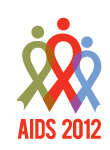 New results from the NA-ACCORD study, involving more than 45,000 North American people living with HIV enrolled in one of 20 cohorts, indicate that the percentage of HIV-positive individuals on antiretroviral therapy with low viral loads increased substantially between 2000 and 2008.
New results from the NA-ACCORD study, involving more than 45,000 North American people living with HIV enrolled in one of 20 cohorts, indicate that the percentage of HIV-positive individuals on antiretroviral therapy with low viral loads increased substantially between 2000 and 2008.
These data were presented by Keri Althoff, PhD, MPH, of Johns Hopkins University Bloomberg School of Public Health and her colleagues on Monday, July 22, at the XIX International AIDS Conference (AIDS 2012) in Washington, DC.
A central goal of the National HIV/AIDS Strategy is to get more people living with HIV on antiretroviral (ARV) treatment and responding well, both virologically and immunologically. One way to determine whether or not this objective is being met is by evaluating data from cohorts following people living with HIV.
The North American AIDS Cohort Collaboration on Research and Design (NA-ACCORD) study utilizes the data being collected by more than 20 such cohorts. Althoff and her colleagues analyzed data collected between 2000 and 2008 to look for trends in ARV use, undetectable viral loads and average CD4 cell counts.
Between 2000 and 2008, the percentage of people living with HIV participating in NA-ACCORD increased from 74 percent to 83 percent.
Notable were the percentages of patients with undetectable viral loads. In 2000, only 46 percent of all NA-ACCORD patients had undetectable viral loads. By 2005, this rate reached 54 percent. And by 2008, 72 percent of all NA-ACCORD participants had undetectable viral loads.
Also of interest were data available for the nearly 4,500 people with HIV who died while participating in NA-ACCORD.
In 2000, 75 percent of those who died were under 50 years of age. In 2008, this percentage decreased to 47 percent—in other words, the majority of those who died were over the age of 50 in the most recent year of available NA-ACCORD data.
“From 2000-2008, increases were observed in the percentage prescribed combination [ARV therapy], the percentage who achieved a suppressed HIV [viral load], and the median age and CD4 count at death,” Althoff and her colleagues concluded. “Our data show improved control of HIV with contemporary management in the U.S. and the utility of NA-ACCORD for monitoring these trends.”
Advertisement
Advertisement
Advertisement






Comments
Comments